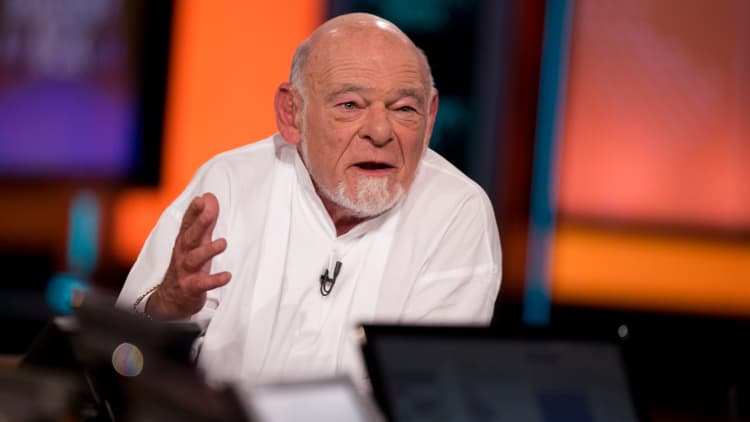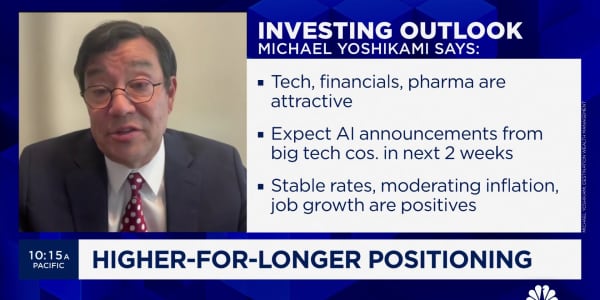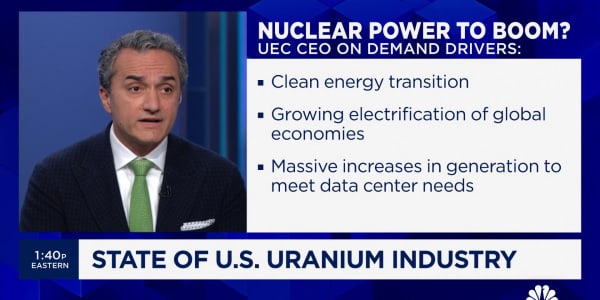Stocks have gone virtually straight up for more than five years. Interest rates are poised to rise. Volatility—a gauge of fear in the marketplace—barely registers. Every time the market swoons, like it did as October began, it snap backs as bullish traders "buy the dip," as Wall Street calls it.
Some say investors are following former Citigroup CEO Chuck Prince's ill-fated advice from 2007. "As long as the music is playing," he said at the time, "you've got to get up and dance."
Prognosticators like Mark Spitznagel think that music is about to end.
"History and logic show that this Fed-manipulated stock market is unsustainable," said Spitznagel, president of $6 billion Universa Investments.
Spitznagel may be talking his book—Universa's core strategy is to make money when the market drops—but he has precedent. The Miami-based hedge fund firm is advised by Nassim Taleb, author of the 2007 book "The Black Swan: The Impact of the Highly Improbable."
Many clients in Universa's "tail hedging" strategy made returns of about 120 percent in October 2008 alone when the stock market plummeted (a tail-hedge refers to the unlikely-to-occur tails of a bell curve-shaped probability graph).
Despite that, the big money isn't rushing to buy insurance—like options on the CBOE —against a crash. Advisors to the largest investors—ultra-high net worth families and institutions like pensions and endowments—have seen a slight up-tick in interest in protective strategies, but not a lot of action.
"Some clients are showing interest in hedging, but it's mostly just conversations at this point," said Justin Sheperd, chief investment officer at $9 billion fund of hedge funds Aurora Investment Management.
Data from investment firm tracker eVestment shows that the assets of funds that should perform best when markets drop and volatility spikes are still far below peak assets.
Hard times for true ‘hedge’ funds
| Year | Short-biased fund return | Tail risk return | Option/Volatility return |
| 2008 | 30.61% | NA | 0.30% |
| 2009 | -20.17% | NA | 14.10% |
| 2010 | -15.25% | -3.30% | 9.30% |
| 2011 | 4.31% | 11.10% | 3.90% |
| 2012 | -14.31% | -20.40% | 10.50% |
| 2013 | -6.41% | -6.00% | 4.60% |
| 2014 | 3.02% | -4.90% | 1.60% |
| Year | Short-biased AUM ($B) | Tail risk AUM ($B) | Option/Volatility AUM ($B) |
| 2008 | $8.86 | NA | $19.89 |
| 2009 | $5.54 | NA | $9.42 |
| 2010 | $4.06 | NA | $8.15 |
| 2011 | $4.51 | NA | $9.32 |
| 2012 | $2.85 | NA | $11.57 |
| 2013 | $2.61 | NA | $9.81 |
| 2014 | $2.79 | $1.96 | $8.79 |
Source: Source: eVestment. AUM is estimated, except Tail Risk.
Read MoreHere's the first 'correction' call...for 2015
So why can't investors protect themselves? Managers of protective funds say simple psychological habits make people forget the past.
"Tail hedging is by definition a very contrarian trade. To be effective, it requires that most people think it is nonsensical," said Universa's Spitznagel. "Then they change their minds after a crash and the cycle begins anew."
Anthony Limbrick, a portfolio manager at 36 South Capital Advisors, a $750 million London-based hedge fund firm focused on tail risk products, gave a seasonal analogy. "Turkey life insurance," he said, "is always cheapest right before Thanksgiving."
A small group of hedge fund managers promise investors protection.
There are the tail-risk funds run by Universa and 36 South, or similar offerings from Pine River Capital Management, Saba Capital Management, Ionic Capital Management and Capula Investment Management.
There are also volatility-focused strategies that perform best when asset prices move up and down quickly. They include Capstone Investment Advisors and Parallax Volatility Advisers.
And there are so-called short-biased or short-only funds that specialize in betting against stocks. Their numbers have dwindled since the crisis, but notable players include Jim Chanos' Kynikos Associates, Dialectic Capital Management, Gotham Asset Management and Kingsford Capital Management.
Read MoreChanos up asmany shorts stumble
Such funds often perform poorly in up markets, making the business difficult to run between corrections and forcing some out of business. That can make it more challenging for investors in hedge funds to choose managers they like.
"The number of institutional-quality, actively managed tail-risk hedging or portfolio protection strategies is relatively small," said Kevin Lenaghan, a director at investment consulting firm Cliffwater "If clients want to allocate to these, there's not like hundreds of them we can get comfortable with…it's a challenge."
Some consultants advise skipping most protective hedge funds.
"Given the underlying risks and recent performance of tail-risk funds…we shy away from them," Rob Christian, head of Research at K2 Advisors and Franklin Templeton Solutions, said in an email. "They don't necessarily pay off during periods of increased market volatility."
Christian noted that the funds were relatively expensive and haven't performed well recently. He said his firms prefer to manage portfolios using hedge funds that can quickly increase or decrease risk.
Read MoreGreenspan: Stocks to see 'significant correction'
Some say simple diversification is better.
"Most clients feel that as long as they focus on diversification, they're OK," John Anderson, president of JPMorgan Alternative Asset Management, said. "They are looking for diversifying strategies that can provide positive returns over paying for hedges which can be costly."
Besides hedge funds, some investors use options to hedge. For example, they could buy a contract that costs pennies on the dollar that would pay off big if the stock market declines by 25 percent in one year, for example.
"Today it's particularly cheap to buy protection—those strategies could add a lot of alpha when the market corrects," Aurora's Sheperd said.
"If market patterns of recent months prevail, there may be a good opportunity to hedge at even lower costs again," added Steven Wieting, chief investment strategist for Citi Private Bank.
Wieting, whose wealthy clients have at least $25 million, said he prefers using derivatives strategies to reduce portfolio risk, not dramatically altering the mix of investments for rare events.
"When the pricing is right, it can help reduce portfolio turnover and improve long-term returns by keeping clients invested," he said.
Read More Bad investing? Blame the brain

While the prices of such options are historically low, they are not free.
"We're not running out there doing every derivative in the book. But we do appreciate that it can be useful at times. You just have to be very thoughtful about it because you can spend a lot of money," said Celia Dallas, chief investment strategist at consultant Cambridge Associates.
Jim McDonald, chief investment strategist for Northern Trust, cautioned against long-term hedging strategies like options.
"Hedging strategies are great if you're a clairvoyant," McDonald said. "You really don't want to spend too much on hedges. You don't want to reduce the overall volatility of your portfolio, because that's where you get your long term returns."
McDonald did say that some protective vehicles can help provide benefit as a diversifier as part of a broader hedge fund portfolio.
Some observers see use of protective strategies as trying to time the market, a devilishly difficult game.
"We start with some humility and know that we are not always going to be able to predict it. The portfolio construction itself is designed to be something that the investor can live with in a downturn," Dallas said.
"You can think about, what if it's 2006 and not fall of 2007. Or if it's 1997 and not March of 2000. That's an unknown. Timing is important," Dallas added.
The lure still remains for protective funds.
"Being fully invested in equities is starting to become less of a one way bet after five years of positive returns," said Limbrick of 36 South. "A big correction may not come for a year or two, or it may turn up tomorrow. A deep correction will come eventually."






